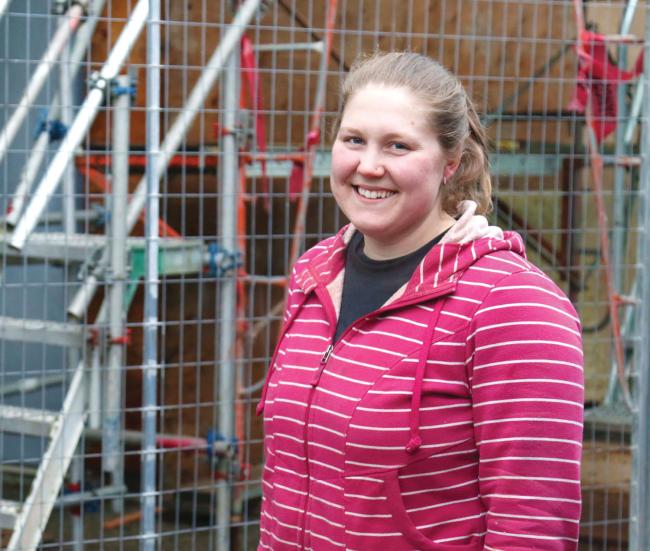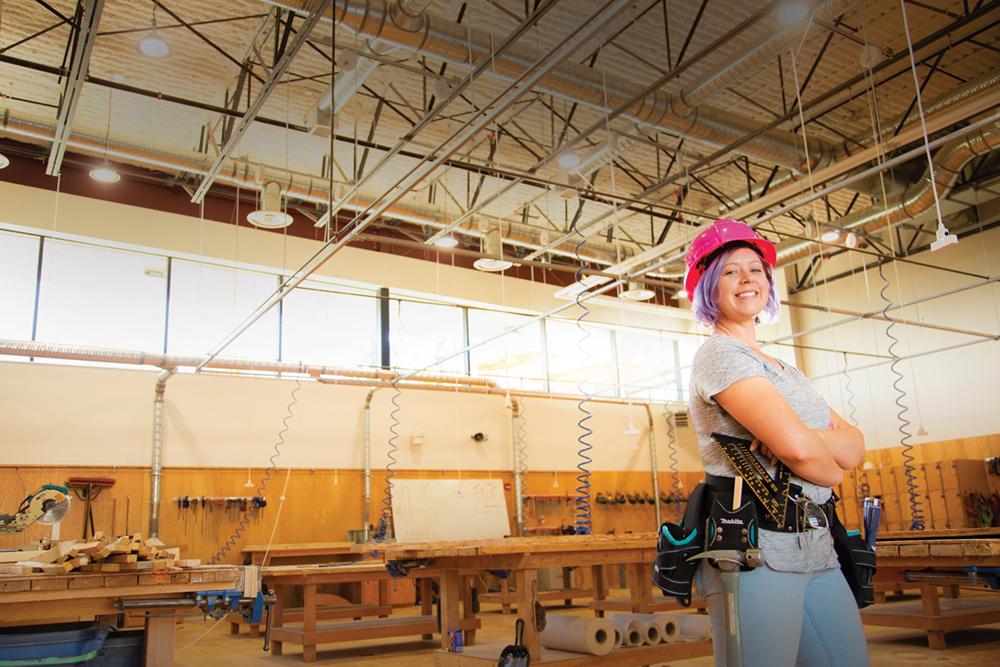Some of BC’s most rewarding and well-paying jobs are in the construction trades, yet less than 5% of those jobs are held by women. Why aren’t more women choosing these high-demand, fulfilling careers, and what can be done about it, especially in light of the looming skills shortage? VIU faculty, alumni and students weigh in.
by Jenn McGarrigle
Jennifer Barton loves everything about the carpentry trade, from designing projects, to using power tools, to being able to step back at the end of the day and admire the progress she’s made.
The 35-year-old, who is enrolled in Vancouver Island University’s Carpentry program after a six-year break from work while her children were very young, recognized long ago that she does not thrive in an office environment. Instead, she prefers to be moving, and she’s enjoying – and doing well in – VIU’s hands-on, eight-month foundation program.
Barton developed a passion for small-scale designs that incorporate different sustainability elements during her former career as an interior designer – a niche she hopes to explore more as a carpenter. Her dream is to one day open her own business specializing in eco-homes and offices. Yet despite her excitement, Barton had reservations about signing up for the program, and she’s preparing to work extra hard once she gets out into the workforce to prove herself.
“The trades are still male-dominated and it’s not a fully gender-inclusive industry,” she says. “I’m preparing myself to get guff on the job site and to work harder to show that I’m fully capable of doing it.”

Addressing the Need for Skilled Workers
More than 240,000 people work in BC’s booming construction sector, but it’s estimated that less than 5% of them are women. Women represent just 9% – approximately 3,500 – of registered apprentices working in BC. Yet demand continues to increase for skilled workers in the construction industry, which offers a wide variety of well-paying career choices. Last year, the province pledged $1.8 million over two years to projects aimed at recruiting, retaining and advancing women in the construction trades.
“Advancing women in the construction trades is a key way to address the need for skilled workers throughout the province,” Melanie Mark, Minister of Advanced Education, Skills and Training, stated in a media release announcing a new Builders Code that aims to create a more supportive, inclusive work environment. “We honour the impact of tradeswomen by looking for more ways to ensure their success continues beyond the classroom.”
The province and key industry partners hope to see women make up 10% of BC’s construction trades by 2028, a standard that hasn’t been attained by any province in Canada yet. The new code of conduct, launched on International Women’s Day this year with partners, including the BC Construction Association, Industry Training Authority, WorkSafeBC and LNG Canada, is supported by a series of innovative services and resources for employers.
Searching for Solutions
At VIU, the Faculty of Trades and Applied Technology is eager to help become part of the solution. Last year, only 6% of the students entering the building trades and automotive, heavy mechanical and heavy equipment operator programs were female.
“We need to do our part to figure out how to make that more robust,” says Glynis Steen, Dean. “Over the next few years, we are building a strategy that creates awareness of trades and applied technology programs as leading to viable career options for non-traditional learners such as female, Indigenous and international students. The only way we can continue to affect the mindset change is to continue to have more and more women in our programs.”
Steen says the faculty will be looking at different options such as working with school districts to build an introduction to the trades program.
“Starting younger is important, getting young women interested, showing them they can be a viable part of the industry,” she says. “A lot of it is personality and what types of work people are drawn to, but part of it is simply that these types of careers were never presented to them as viable options. What many might not realize is that while hard labour can be involved in these careers, it’s not just about banging nails into wood – there’s a lot of problem-solving and technical skills required to become a successful tradesperson in this day and age.”
Deanna Littlejohn, who has taught in VIU’s Electrician program for the past 12 years, says exposing women to these options at a younger age is important. For her, having family members in the trade motivated her to explore it as an option 40 years ago.
“I don’t think females are encouraged to get into the trades unless their parents are already in the trades and recognize the benefits, such as making good money right out of the gate and the diverse, challenging pathways your career can take,” she says. “It comes down to marketing and exposure – meeting other women who have been successful and hearing their stories.”
Littlejohn, who worked for years in a wide range of jobs, says she often felt pressure to over-perform and prove herself when starting a new job. She says sometimes colleagues on job sites will “test” their female counterparts, whether they’re aware that they are doing it or not.
“Just letting some of that wash off your back is important,” she says. “You have to have a strong personality and do your job with blinders on sometimes.”
Cameron Frenette, Chair of VIU’s Carpentry program, says the foundation program consistently enrolls two or three women per class, and they are always exceptional, above-average students.
“Basically, we are only getting the most dedicated,” he says. “We’re only getting the women who are kicking down the door and so resilient that nothing breaks them down; the rest are not seeing that door as open yet. I think stigma plays a big role – both the stigma that a trades career is something you ‘end up in’ because you can’t hack it elsewhere, and also the gender stigma – the belief that it’s ‘men’s work.’”

“I do have concerns as a single parent – most day cares are open from 7:30 am to 5:30 pm, so I would have to find a job that enabled me to work between those hours,” she says.
Barton thinks the mindset shift is coming. She was able to get funding to enter the program through WorkBC’s Single Parent Initiative, and when she was doing some labour market research to meet the program’s entrance requirements, one employer phoned her back specifically because she was a female looking to get into the industry and he was interested in diversifying his employee mix.
“I think there is definitely a movement towards including more women,” she says.
Frenette would like to see more scholarships and bursaries available for women entering the trades. He, like Barton, thinks change is coming to the job site. “Barriers do still exist, but much has changed and continues to change,” he says.
Sidebar: Labour Market Opportunities for Women in the Trades
• Less than 5% of working women in the province are in the construction trades.
• 903,000 job openings expected over the next decade according to the 2018 Labour Market Outlook, with almost 80% requiring some level of post-secondary education or skills training, including 41,000 jobs in construction trades.
• $74 billion: total estimated value of current major projects underway in BC, in addition to the $40-billion LNG Canada project in northern BC
Sidebar: VIU Alum Balances Work and Curling

“With carpentry, what you’re doing varies quite a bit from job to job, it’s never the same, which is nice,” she says.
While she doesn’t feel singled out because of her gender at the worksite –a circumstance she attributes to her employer, Knappett Projects, and the respectful way the company treats employees – Van Osch says she is still one of the few, and sometimes the only, female on the job site.
“If you talk to my mom’s generation, people that age are definitely shocked that I’m a carpenter,” she says. “It’s seen as a male-dominated industry and it still is, but it’s changing. You hear stories of supers who would yell and scream, and that isn’t acceptable anymore. Still, you have to have a fairly thick skin, especially when you first start. People bug each other and you have to be willing to let some of that go.”
Van Osch, who is also a national-level curler, says she is a good example of how employers can make unusual schedules work – when the curling season gets intense, she’s spending her time on ice rinks instead of job sites.
“They knew when they hired me that I was a curler,” she says. “In the wintertime, they joke around and call me ‘part-timer,’ but they always ask how I did when I get back.”
Sidebar: VIU Offers Women in Trades Training
Funding is available to help women receive funding in one of two pathways:
- Trade Sampler Programs (link to information below on page)
- Trade specific Foundation Programs (link to information below on page)
For more information, visit Women in Trades Training.





